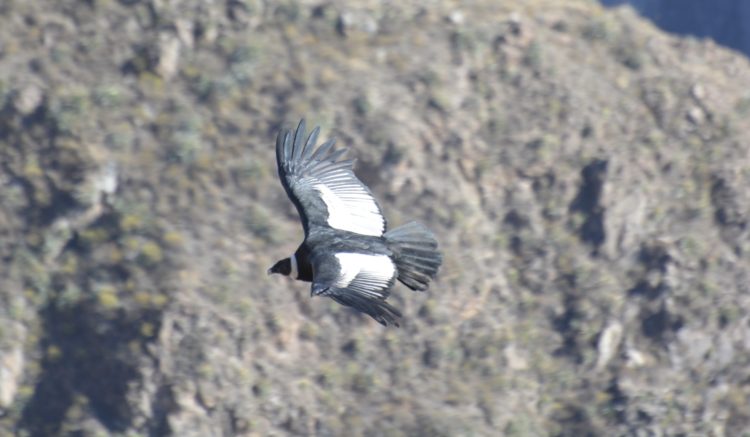Table of Contents
Overview
The Colca Canyon, located about 160 kilometres northwest of Arequipa, where condors soar, is one of the deepest canyons in the world, reaching depths of over 3,270 metres (10,730 feet), more than twice as deep as the Grand Canyon in the United States. This dramatic landscape is not only a natural wonder but also a place of cultural and historical significance, with pre-Inca terraces still in use today by local farmers. A trip to Colca Canyon is a journey through some of Peru’s most breathtaking scenery, from the high-altitude plains to the steep canyon walls, with soaring condors providing a majestic sight over the landscape.
The canyon is a natural wonder that showcases Peru’s extraordinary geography, with dramatic cliffs, verdant terraces, smoking volcanoes and some of the best wildlife viewing in the Andes. We stayed at the well appointed Colca Trek Lodge in Pinchollo a short drive from one of the principal viewing sites for the condors.




Colca Canyon and Condors, Peru
Geography and Climate
The Colca Valley, through which the Colca River flows, is not just known for its immense depth but also for the terraced fields that line the canyon walls, a testament to the engineering prowess of the ancient Collagua and Cabanas cultures. The deep canyon’s microclimates allow for a variety of crops to be cultivated, including quinoa, corn, and potatoes.
To reach the canyon, you must pass through Patapampa, a high-altitude pass at 4,910 metres (16,108 feet), one of the highest points on the journey. From here, you’ll witness breathtaking views of nearby volcanoes, including Ampato and the smoking Sabancaya.



Sabancaya and Patapampa Pass, Colca Canyon, Peru
Chivay and Yanque
Chivay, the gateway town to the Colca Canyon, is a bustling hub with a vibrant market. Here, locals sell handicrafts, fresh produce, and warm alpaca clothing—ideal for the chilly nights that descend upon the canyon. Chivay is also home to the La Calera Hot Springs, where visitors can soak in the naturally heated mineral waters after a day of exploring.
Further along the canyon is Yanque, a quaint village known for its picturesque main square and the stunning Iglesia de la Inmaculada Concepción, a colonial church with a façade carved from white volcanic stone. The area around Yanque is also perfect for short hikes, offering sweeping views of the terraced fields and the canyon below.



Chivay, Colca Canyon
Wildlife and the Andean Condor
No visit to Colca Canyon is complete without seeing the majestic Andean condor (vultur gryphus) in flight. These massive birds, with a wingspan of up to 3.3 metres (10.8 feet), are often seen soaring above the canyon, taking advantage of the thermal air currents that rise from the depths below. The best place to view the condors is at the Cruz del Condor viewpoint, where we spent the morning watching these magnificent birds glide effortlessly through the air.
Other wildlife in the region includes herds of vicuñas and alpacas grazing on the high-altitude plains. Vicuñas produce some of the finest wool in the world, prized for its softness and rarity. Vizcachas (Andean rodents) and even the occasional Andean fox can also be spotted on the canyon’s rugged slopes.








Condors in the Colca Canyon, Peru
Hot Springs and Altitude Remedies
After a long day exploring the canyon, nothing beats a relaxing soak in the La Calera Hot Springs in Chivay. These natural thermal baths are heated by volcanic activity and are believed to have therapeutic properties. The springs, with temperatures around 38°C (100°F), are a great way to relax set amidst a spectacular backdrop of mountains and valleys.
At such high altitudes, visitors often experience altitude sickness or soroche. Locals swear by mate de coca (coca leaf tea), a traditional remedy used for centuries by indigenous Andean people to help alleviate the symptoms of altitude. You’ll find coca leaves for sale in markets, or simply enjoy a cup.
| Traditional Clothing of the Colca Canyon The local people of the Colca Canyon, predominantly of Quechua and Aymara heritage, are known for their vibrant, traditional clothing that reflects both their indigenous roots and the influence of Spanish colonialism. One of the most striking elements of their attire is the hats, which are not only practical for shielding against the sun but also carry deep cultural significance. Women in the region often wear elaborately decorated hats, with two distinct styles associated with different ethnic groups: the Cabana people wear hats adorned with intricate, multicoloured embroidery, while the Collagua people wear simpler, more structured white hats with fewer embellishments. The designs on these hats often symbolize the wearer’s community and personal status. In addition to hats, women wear brightly coloured skirts called polleras, layered and embellished with detailed embroidery, often paired with shawls that are fastened with large silver tupu pins, a traditional accessory passed down through generations. Men’s traditional clothing is simpler but still reflects the rich colours and patterns of the region, with embroidered belts and ponchos common for festivals and special occasions. |







Final Thoughts
Colca Canyon is a destination of profound natural beauty and exhilarating adventure. Its vast depth, dramatic landscapes, and rich cultural history make it one of Peru’s most awe-inspiring natural wonders. The opportunity to witness the majestic Andean condors soaring above the canyon and to explore the terraced fields and quaint villages of Chivay and Yanque offers a deeply rewarding experience. The combination of spectacular scenery, unique wildlife, and the chance to engage with the local cultures creates a memorable journey that highlights the best of Peru’s natural and cultural offerings. Colca Canyon promises a profound connection to the natural world and a deep appreciation for the resilience and beauty of the Andean highlands.





Colca Trek Lodge, Pinchollo, La Calera Hot Springs and Viewpoint at Patapampa, Colca Canyon
Date: 30/06/2018 to 01/07/2018 – Revised 04/11/2024
